 In the 70-ties I had the opportunity to study aikido with Hirokazu Kobayashi. In that time I didn’t understand the concept of meguri* and tenshi (body rotation). Kobayashi stressed on many occasions the spiral movement of the wrist and the dropping of the elbow. Using the koshi was also one of his favorite remarks.
In the 70-ties I had the opportunity to study aikido with Hirokazu Kobayashi. In that time I didn’t understand the concept of meguri* and tenshi (body rotation). Kobayashi stressed on many occasions the spiral movement of the wrist and the dropping of the elbow. Using the koshi was also one of his favorite remarks.
It was Akira Hino’s explanation about “tenshi-kei”, the power of internal rotation, that gave me a better understanding of meguri* and the use of koshi (lower back).
 *A defensive movement when grasped at the wrist, is the skill of “meguri”, meaning flexibility, rotation of the forearms. The use of the koshi as engine for power release increases the efficiency of defense action.
*A defensive movement when grasped at the wrist, is the skill of “meguri”, meaning flexibility, rotation of the forearms. The use of the koshi as engine for power release increases the efficiency of defense action.
Meguri and tenshi are the main components in 7-hon no kuzuzhi, the balance disturbing exercises of Tomiki’s Aikido. Without spiral rotations, the balance disturbing will only rely on muscular power of the arm. Only by using “rendo” or synchronizing body movements, the power of meguri and tenshi will create the necessary balance disturbing followed by a throw or control action.
7-hon no kuzushi
 The concept of balance disturbing in Tomiki’s Aikido is partly the result of the influence of Kodokan Judo, but also Morhei Ueshiba’s Aikido is prominent present.
The concept of balance disturbing in Tomiki’s Aikido is partly the result of the influence of Kodokan Judo, but also Morhei Ueshiba’s Aikido is prominent present.
Morihei Ueshiba’s Aikido is build around the use of rotational and spiral power.
In the picture, there is the downward rotational movement of the body. By using a meguri pulling action on the sleeve or arm, the rotational movement changes into a downward spiral movement.
Some teachers use an almost linear approach, others use a more circular approach. This of course will affect the perception and will have a negative influence on the performance of lesser skillful practitioners. The external movements has to combined with internal movements, this is only possible through the skill of “rendo”.
The 7-hon no kuzushi is build around :
- vertical movement
- horizontal movement
- central axis rotation
The basic positions are “aigamae” & “gyakugamae” for the vertical and horizontal movements. You will notice, Uke is grasping the wrist with the right hand and keeps the left hand ready for the follow-up action. This can be a strike with the fist or another grasping action.
The central axis rotation start from a rear attack position. Of course the central axis rotation is also present in the vertical and horizontal movements.
When studying 7-hon no kuzushi, we have to understand these movements are simplified and will not work in a randori environment without adaptation to the circumstances.
The movement pattern of these exercises has to be written in the subconscious part of the mind for immediate access when necessary
Vertical movement

There are 2 vertical modes in 7-hon no kuzushi:
- upward – jodan-kuzushi is mostly characterized by a hineri movement
- aigamae
- gyakugamae
- downward – gedan kuzushi – mostly characterized by a “gaeshi” movement
- aigamae
- gyakugamae
Horizontal movement

Horizontal kuzushi movements are mostly characterized by a hineri movement
When performing from the right posture, opponent can attack from 2 positions:
- aigamae
- gyakugamae
Central axis rotation
The idea here is an application of spinning top power.**
**A spinning top is a toy designed to spin rapidly on the ground, the motion of which causes it to remain precisely balanced on its tip due to its rotational inertia.
Meguri and tenshi in 7-hon no kuzushi
A “kuzushi” movement is succesful when we consider the following:
- target: the wrist attacked by the opponent
- the hand of the grasped wrist to indicate the direction
- the elbow: the transfer joint for the full-body power by using meguri and tenshi
The target
Opponent can grasp the wrist according 2 modes:
- omote dori – outside wrist
- go-no-sen
- sen-no-sen
- ura dori – inside wrist
- go-no-sen
- sen-no-sen
Each mode has an influence on the hand movement of the grasped wrist. In the go-no-sen mode, opponent has the initiative of the grasping. Defender has the initiative in the sen-no-sen mode.
There are 2 grasping methods:
- junte dori – regular grip
- gyakute dori – reverse grip
In 7-hon no kuzushi only the junte dori is covered. Gyakute dori or reverse grip is used in kote gaeshi, kote mawashi ……..
How to grasp a wrist?
Grasping a wrist is “almost identical” as grasping the hilt of a sword.
Most of the holding power is in the thumb and middle finger. Little finger, ringfinger and index finger are envelopping the wrist. Grasping is not a static action. The dynamics of grasping is the result of “meguri” and “tenshi”.
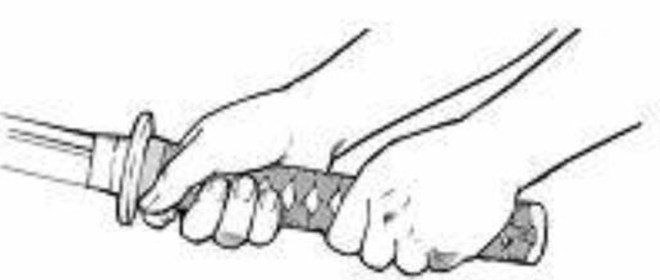

The hand of the grasped wrist
As already mentioned, Tori can act in a go-no-sen or sen-no-sen mode.
The hand in most of the cases can move freely. There are 2 basic modes:
- upward
- downward
By using the turning point in the hand, the tendon of in the forearm will stretch. If the point of turning is close to the wrist, the stretching will not happen. By stretching the tendon(s) it is easier to use the elbow in the desired direction.

Meguri and the use of elbow
Meguri is based upon the flexibility and rotation of the forearm.
The flexibility and rotation of the forearm and elbow is depending on the connection with the kyokotsu, a point at the breastbone. When pulling in the arm by using the biceps muscle, the shoulder will be locked and the power from the central body cannot travel through the elbow to the hand.
In his book “Goshi Jutsu Nyumon”, Kenji Tomiki used a picture to explain hand and elbow movement around a fulcrum, the grasping point by opponent. The picture is only showing the principle of leverage and does not include meguri action.
It is not always possible to move efficiently just by using simple leverage as seen in Tomiki’s fulcrum picture. The elbow movement is only possible if the shoulder is free of tension.

 Rotation of the forearm when grasped at the wrist is possible by using the skill of “tenshi” or internal rotation. Tenshi-kei is the power of tenshi and can be used to make waza efficiency higher.
Rotation of the forearm when grasped at the wrist is possible by using the skill of “tenshi” or internal rotation. Tenshi-kei is the power of tenshi and can be used to make waza efficiency higher.
We can use body rotation and internal rotation at the same time to increase waza efficiency. An example can be the rear wrists grasping where we use an external body rotation and tenshi or internal rotation.
Basic 7-hon no kuzushi
7-hon no kuzushi is an exercise to study body movements which can be used in all forms of balance disturbing. The belief that 7-hon no kuzushi is the method for balance disturbance is a delusion. It is an exercise to learn how to use the body with external and internal movements.
There are many versions of 7-hon no kuzushi. The early versions are created when Kenji Tomiki was still teaching. During the creation of Koryu no kata, the study of 7-hon no kuzushi became a part of the training and was incorporated into Koryu no kata daiyon.
History of Koryu no kata
Takeshi Inoue the autor of a book on Koryu no kata, who knows in detail the background of the creation of the Koryu no kata wrote:
In about 1958, we practiced mainly the unsoku, tandoku undo, yonhon no kuzushi (a former version of the nanahon no kuzushi/7-hon no kuzushi) as well as the jugohon no kata (basic15 kata). In around 1960, the junanahon no kata ( basic17 kata) and the roppon no kuzushi/6-hon no kuzushi were created and then the dai-san no kata was devised as a kata of classical techniques. During the mid-60 Ohba Sensei and others worked on the creation of the kata forms of the dai-ichi (first) to dai-roku (sixth), which we practice as the koryu no kata, in order to work on techniques for demonstrations and for purposes other than randori. What Ohba Sensei particularly stressed in formulating these kata was the organization of different techniques in such a way that students could learn connections between techniques easily and naturally. After he had organized the techniques to some extent, Ohba Sensei reported to Tomiki Sensei and demonstrated what he had done for him. He received some advice from Tomiki Sensei and then added corrections to the kata. (“Bujin Hideo Ohba,” Kyogi Aikido Soseiki no Ayumi; Ohba Hideo Sensei o Shinobu, p. 67)
Some examples from an old Waseda movie 1975
7-hon no kuzushi by Takaeshi Inoue
The illustrations: Tomiki Aikido-Book 1-1978 by dr Lee ah Loi
Tori: Takeshi Inoue
Jodan – aigamae
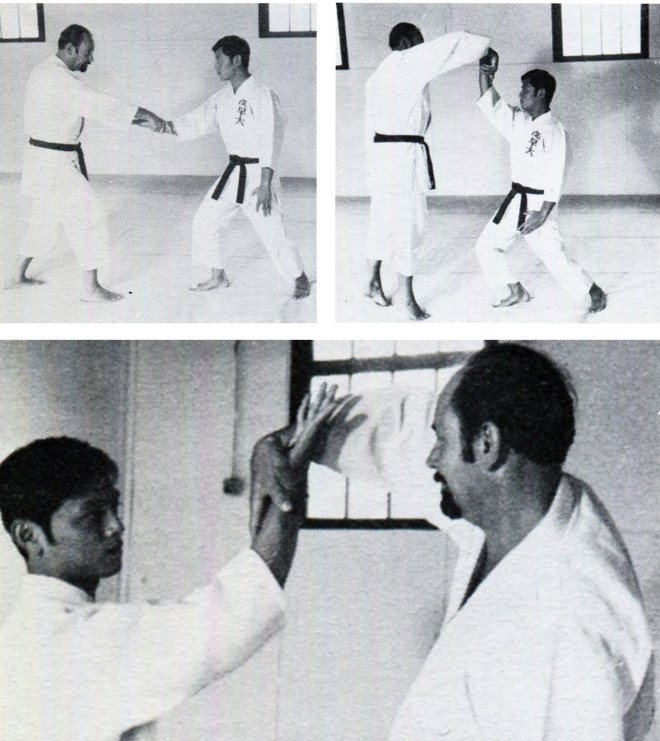
Jodan – gyakugamae

Chudan aigamae
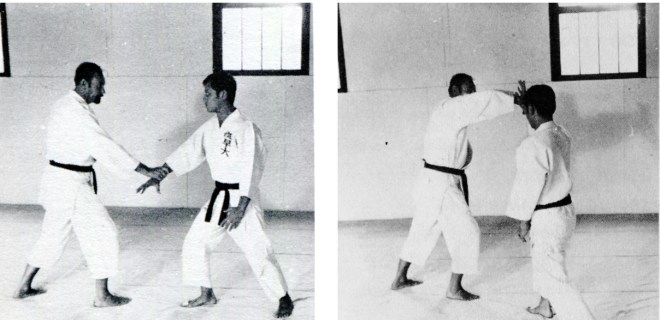
Chudan gyakugamae
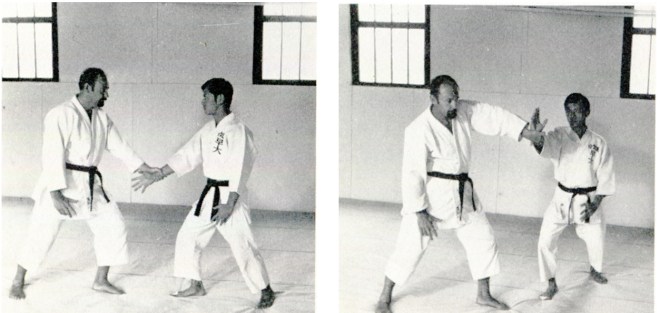
Gedan aigamae
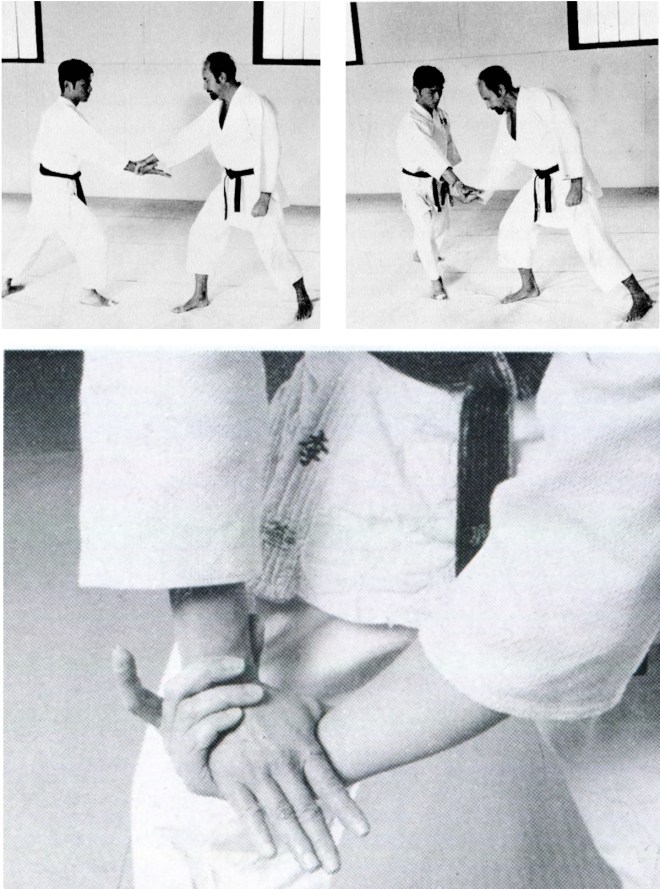
Gedan gyakugamae
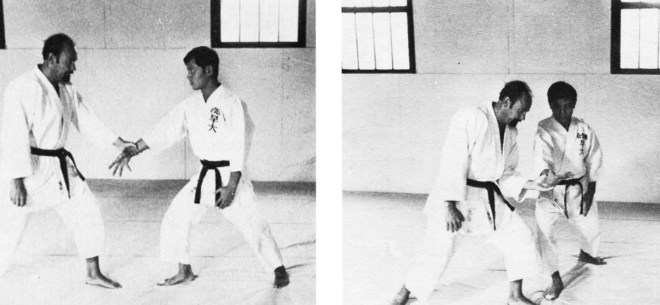
Ushiro

7-hon no kuzushi application examples
Some applications we can find in “Koryu no kata dai yon”.
Examples are:
Jodan kuzushi aigamae nage waza

Jodan kuzushi gyakugamae nage waza

From “Koryu no kata dai roku”
Jodan & gedan kuzushi

More randori oriented example:
Hiki otoshi











7 thoughts on “Tenshi-Meguri & 7-hon no kuzushi”